- Cucurbit powdery mildew season is here. For a review of CPM control strategies please click here.
- Cucurbit downy mildew has been reported on cucumber in western MI and as far north as North Carolina on cucumber. For a review of CDM control please click here. To track the progress of CDM on your phone or PC please visit the CDM forecasting website.
- No reports of Late blight in region. To track the progress of Late blight in the US please click here.
- Basil downy mildew (BDM) has been reported in southern New Jersey on BDM susceptible sweet basil. All growers are encouraged to initiate preventative fungicide programs on DMR and non-DMR basil. For control options and to follow the progress of BDM in the US on your phone or PC please click here.
- Bacterial canker has been reported in fresh-market tomato. For a review of bacterial canker in tomato please see report by Dr. Sally Miller at The Ohio State University by clicking here.
- Diplodia leaf streak, a fungal disease, was identified in sweet corn this past week. Symptoms include the development of numerous pycnidia which produce conidia within the lesions on infected corn leaves. For nice reviews, please see report by Dr. Kiersten Wise and colleagues from the University of Kentucky and report by Dr. Steve Johnson at the University of Maine.
- White mold, caused by Stromatina cepivorum, has been reported in garlic. For more information, please see report by Crystal Stewart and Frank Hay from Cornell University.
- Angular leaf spot has been reported in summer squash. Look for angular lesions delimited by leaf veins and ‘shotholes’ in infected leaves that develop after periods of hot, dry weather.
- Phytophthora blight has been reported in pepper and cucurbit crops.
- Rhizoctonia and Pythium root rot have been reported in pepper. For a review of identifying and controlling root rots please click here.
- Septoria leaf spot and bacterial blight have been reported in parsley.
- Timber rot, or white mold, has been reported in tomato.
- White rust and Cercospora have been reported in spinach.
- Bacterial leaf spot has been reported in sweet basil. BLS of sweet basil is a relatively new disease of basil in the US. The bacterium has a large host range and can survive and overwinter in the soil on infested plant debris. Disease development is favored by hot, humid, rainy weather. Periods of hot, dry weather will help mitigate disease development.
- Sand blasting has been reported on a number of leafy green and other crops these past few weeks. Injury from sand blasting predisposes plants to bacterial infections. Remember, all bacteria need a wound or a natural opening, such as a stomata, to gain entry into the plant. Fields with extensive injury need to be scouted regularly, and most likely will need to be sprayed regularly with a copper fungicide or disinfectant-type product to help mitigate infection and spread.
- For a review on how to avoid sunscald injury on transplanted crops please click here.
- With the on and off again heavy rains we have been getting, along with warmer weather, all growers should consider applying at-transplanting fungicides for root rot control. Please click here to see these articles.
- The 2020/2021 Commercial Vegetable Production Recommendations Guide is available for free online! With many county offices running reduced hours or being closed this is the easiest way to obtain the newest recommendations.
- For a quick review on managing fungicide resistance development using tank mixes and fungicide rotations, and information on FRAC group 4, FRAC group 7, and FRAC group 3 and FRAC group 11 fungicides please click on hyperlinks.
Organic Farm Advisory
The Plant & Pest Advisory serves NJ growers by reporting on important pests and recommending responses that are grounded in reproducible trials.
 Articles in this section contain information helpful to the NJ commercial organic grower.
Articles in this section contain information helpful to the NJ commercial organic grower.
 Sharing organic practice trial results between land-grant universities is a cost effective way to create a common knowledge base built on the strengths of individual programs. In the sidebar, find institutions with programs in organic agriculture which augment knowledge developed at the Rutgers New Jersey Ag Experiment Station.
Sharing organic practice trial results between land-grant universities is a cost effective way to create a common knowledge base built on the strengths of individual programs. In the sidebar, find institutions with programs in organic agriculture which augment knowledge developed at the Rutgers New Jersey Ag Experiment Station.
 Rutgers Cooperative Extension Field Guides: These concise guides help with decision making from pre-planting to harvest. For each crop listed, learn what pests to proactively look for as the season progresses, how to look for them, and when to take action.
Rutgers Cooperative Extension Field Guides: These concise guides help with decision making from pre-planting to harvest. For each crop listed, learn what pests to proactively look for as the season progresses, how to look for them, and when to take action.
Vegetable Disease Update – 6/26/20
IPM Update 6/24/20
Sweet Corn
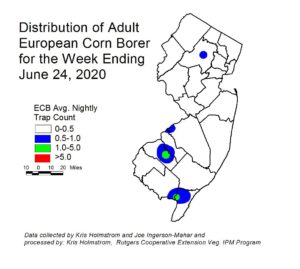 European corn borer (ECB) moth catches have declined somewhat over the past week. At this time, activity is highest in Gloucester County and along the Cape May/Cumberland bay shore (see ECB map at left). Catches are widely dispersed. Larval infestations above 20% continue into the northern counties this past week. Larval infestations should be expected to continue for approximately another 2 weeks.
European corn borer (ECB) moth catches have declined somewhat over the past week. At this time, activity is highest in Gloucester County and along the Cape May/Cumberland bay shore (see ECB map at left). Catches are widely dispersed. Larval infestations above 20% continue into the northern counties this past week. Larval infestations should be expected to continue for approximately another 2 weeks.
As always, look for the characteristic “shot-hole” type of feeding (photo below at right) and consider treating when infested plants exceed 12% in a 50 plant sample. As plantings proceed to the pre-tassel stage, ECB larvae may be found in emerging tassels (see photo at left). It is a good idea to treat individual plantings as they move into the full tassel/first silk stage one time. This eliminates any ECB larvae that have emerged with the tassels as they begin to move down the stalk to re-enter near developing ears.
Useful insecticides for this particular application include synthetic 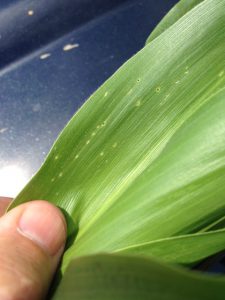 pyrethroids (IRAC Grp 3), spinosyns (including OMRI approved Entrust) IRAC Grp 5), and diamides such as Coragen (IRAC Grp 28) or materials such as Besiege which include the active ingredient in Coragen. Synthetic pyrethroids alone should NOT be used for corn earworm (CEW) protection on silking corn. Control with these materials is very inconsistent.
pyrethroids (IRAC Grp 3), spinosyns (including OMRI approved Entrust) IRAC Grp 5), and diamides such as Coragen (IRAC Grp 28) or materials such as Besiege which include the active ingredient in Coragen. Synthetic pyrethroids alone should NOT be used for corn earworm (CEW) protection on silking corn. Control with these materials is very inconsistent.
The highest nightly trap catches of ECB for the week ending 6/24/20 are as follows:
| Downer 2 | Eldora 1 | Milltown 1 |
| Blairstown 1 | Farmingdale 1 | Port Colden 1 |
| Cinnaminson 1 | Lawrenceville 1 | Springdale 1 |
| Denville 1 | Matawan 1 | Tabernacle 1 |
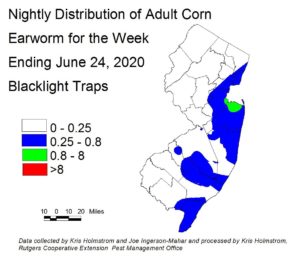 Corn earworm (CEW) moth captures increased slightly in blacklight traps this past week. As early plantings are now in the silk stage, they will need protection from this pest. Blacklight catches sere highest overall along the coast (see map at left).
Corn earworm (CEW) moth captures increased slightly in blacklight traps this past week. As early plantings are now in the silk stage, they will need protection from this pest. Blacklight catches sere highest overall along the coast (see map at left).
The highest nightly trap catches of CEW in black light traps for the week ending 6/24/20 are as follows:
| Matawan 2 | Elm 1 | New Egypt 1 |
| Bellemeade 1 | Green Creek 1 | Sergeantsville 1 |
| Crosswicks 1 | Hillsborough 1 | Springdale 1 |
| Eldora 1 | Milltown 1 | Tabernacle 1 |
IPM Update 6/17/20
Sweet Corn
 European corn borer (ECB) moth catches increased somewhat over the past week although higher numbers were recorded in a relatively low number of locations. At this time, activity is highest in Gloucester and central Morris counties (see ECB map at left). Catches remain widely dispersed. Larval infestations into the 30+% range were detected as far north as Morris County this past week. As moth catches begin to fall, larval development and damage increase. We expect that these infestation rates will continue to climb for the next 1-2 weeks in many parts of the state.
European corn borer (ECB) moth catches increased somewhat over the past week although higher numbers were recorded in a relatively low number of locations. At this time, activity is highest in Gloucester and central Morris counties (see ECB map at left). Catches remain widely dispersed. Larval infestations into the 30+% range were detected as far north as Morris County this past week. As moth catches begin to fall, larval development and damage increase. We expect that these infestation rates will continue to climb for the next 1-2 weeks in many parts of the state.
 Look for the characteristic “shot-hole” type of feeding (photo below at right) and consider treating when infested plants exceed 12% in a 50 plant sample. As plantings proceed to the pre-tassel stage, ECB larvae may be found in emerging tassels (see photo at left). It is a good idea to treat individual plantings as they move into the full tassel/first silk stage one time. This eliminates any ECB larvae that have emerged with the tassels as they begin to move down the stalk to re-enter near developing ears.
Look for the characteristic “shot-hole” type of feeding (photo below at right) and consider treating when infested plants exceed 12% in a 50 plant sample. As plantings proceed to the pre-tassel stage, ECB larvae may be found in emerging tassels (see photo at left). It is a good idea to treat individual plantings as they move into the full tassel/first silk stage one time. This eliminates any ECB larvae that have emerged with the tassels as they begin to move down the stalk to re-enter near developing ears.
Useful insecticides for this particular application include synthetic  pyrethroids (IRAC Grp 3), spinosyns (including OMRI approved Entrust) IRAC Grp 5), and diamides such as Coragen (IRAC Grp 28) or materials such as Besiege which include the active ingredient in Coragen. Synthetic pyrethroids alone should NOT be used for corn earworm (CEW) protection on silking corn. Control with these materials is very inconsistent.
pyrethroids (IRAC Grp 3), spinosyns (including OMRI approved Entrust) IRAC Grp 5), and diamides such as Coragen (IRAC Grp 28) or materials such as Besiege which include the active ingredient in Coragen. Synthetic pyrethroids alone should NOT be used for corn earworm (CEW) protection on silking corn. Control with these materials is very inconsistent.
The highest nightly trap catches of ECB for the week ending 6/17/20 are as follows:
| Eldora 2 | Crosswicks 1 | Medford 1 |
| Allentown 1 | Denville 1 | New Egypt 1 |
| Blairstown 1 | Downer 1 | Springdale 1 |
| Cinnaminson 1 | Elm 1 | Tabernacle 1 |
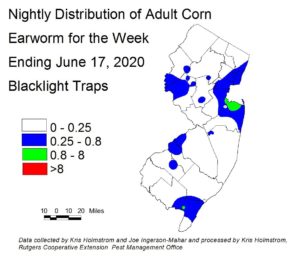 Increased catches of corn earworm (CEW) moths were recorded this past week. As early plantings proceed to full tassel and on to silk, they will need protection from this pest. Blacklight catches (see map at left) were scattered, but higher in locations than the previous week.
Increased catches of corn earworm (CEW) moths were recorded this past week. As early plantings proceed to full tassel and on to silk, they will need protection from this pest. Blacklight catches (see map at left) were scattered, but higher in locations than the previous week.
The highest nightly trap catches of CEW in black light traps for the week ending 6/17/20 are as follows:
| Matawan 3 | Clinton 1 | Hackettstown 1 |
| Asbury 1 | Downer 1 | Hillsborough 1 |
| Bellemeade 1 | Eldora 1 | New Egypt 1 |
| Cinnaminson 1 | Green Creek 1 | Springdale 1 |
Vegetable Disease Update – 6/12/20
- Cucurbit powdery mildew season is here. For a review of CPM control strategies please click here.
- Cucurbit downy mildew has been reported as far north as southern Georgia on cucumber and cantaloupe and in South Carolina on cucumber. For a review of CDM control please click here. To track the progress of CDM please visit the CDM forecasting website.
- No reports of Late blight in region. To track the progress of Late blight in the US please click here.
- Basil downy mildew has been reported central TN from basil started in the greenhouse and in the field in southern FL to date. None has been reported in the region. To follow the progress of BDM in the US please click here.
- Angular leaf spot has been reported in summer squash. Look for angular lesions delimited by leaf veins and ‘shotholes’ in infected leaves that develop after periods of hot, dry weather.
- Phytopthora blight has been reported in squash.
- Rhizoctonia and Pythium root rot have been reported in pepper. For a review of identifying and controlling root rots please click here.
- Septoria leaf spot and bacterial blight have been reported in parsley.
- Bacterial canker and speck have been reported in fresh-market tomato.
- Timber rot, or white mold, has been reported in tomato.
- White rust and Cercospora have been reported in spinach.
- Bacterial leaf spot has been reported in sweet basil. BLS of sweet basil is a relatively new disease of basil in the US. The bacterium has a large host range and can survive and overwinter in the soil on infested plant debris. Disease development is favored by hot, humid, rainy weather. Periods of hot, dry weather will help mitigate disease development.
- Sand blasting has been reported on a number of leafy green and other crops these past few weeks. Injury from sand blasting predisposes plants to bacterial infections. Remember, all bacteria need a wound or a natural opening, such as a stomata, to gain entry into the plant. Fields with extensive injury need to be scouted regularly, and most likely will need to be sprayed regularly with a copper fungicide or disinfectant-type product to help mitigate infection and spread.
- For a review on how to avoid sunscald injury on transplanted crops please click here.
- With the on and off again heavy rains we have been getting, along with warmer weather, all growers should consider applying at-transplanting fungicides for root rot control. Please click here to see these articles.
- The 2020/2021 Commercial Vegetable Production Recommendations Guide is available for free online! With many county offices running reduced hours or being closed this is the easiest way to obtain the newest recommendations.
- For a quick review on managing fungicide resistance development using tank mixes and fungicide rotations, and information on FRAC group 4, FRAC group 7, and FRAC group 3 and FRAC group 11 fungicides please click on hyperlinks.
IPM Update 6/10/20
Sweet Corn
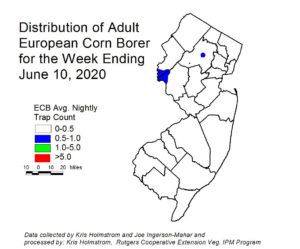 European corn borer (ECB) moth catches have declined over the past week despite increasing temperatures. At this time, activity is highest near the Hunterdon/Warren County border, although this is still a low level population (see ECB map at left). The number of traps registering moderate catches remains low, and catches are widely dispersed. Another week of trapping will clarify whether this decrease in activity signifies the end of the first flight. A number of corn plantings are now in whorl through tassel stages and able to support ECB larvae. Larval infestations as high as 12% were detected as far north as Hunterdon County this week. As moth catches fall, larval development and damage increase. We expect that with a few more warm days, these infestation rates will climb quickly in many parts of the state.
European corn borer (ECB) moth catches have declined over the past week despite increasing temperatures. At this time, activity is highest near the Hunterdon/Warren County border, although this is still a low level population (see ECB map at left). The number of traps registering moderate catches remains low, and catches are widely dispersed. Another week of trapping will clarify whether this decrease in activity signifies the end of the first flight. A number of corn plantings are now in whorl through tassel stages and able to support ECB larvae. Larval infestations as high as 12% were detected as far north as Hunterdon County this week. As moth catches fall, larval development and damage increase. We expect that with a few more warm days, these infestation rates will climb quickly in many parts of the state.
 Look for the characteristic “shot-hole” type of feeding (photo below at right) and consider treating when infested plants exceed 12% in a 50 plant sample. As plantings proceed to the pre-tassel stage, ECB larvae may be found in emerging tassels (see photo at left). It is a good idea to treat individual plantings as they move into the full tassel/first silk stage one time. This eliminates any ECB larvae that have emerged with the tassels as they begin to move down the stalk to re-enter near developing ears.
Look for the characteristic “shot-hole” type of feeding (photo below at right) and consider treating when infested plants exceed 12% in a 50 plant sample. As plantings proceed to the pre-tassel stage, ECB larvae may be found in emerging tassels (see photo at left). It is a good idea to treat individual plantings as they move into the full tassel/first silk stage one time. This eliminates any ECB larvae that have emerged with the tassels as they begin to move down the stalk to re-enter near developing ears.
Useful insecticides for this particular application include synthetic  pyrethroids (IRAC Grp 3), spinosyns (including OMRI approved Entrust) IRAC Grp 5), and diamides such as Coragen (IRAC Grp 28) or materials such as Besiege which include the active ingredient in Coragen. Synthetic pyrethroids alone should NOT be used for corn earworm (CEW) protection on silking corn. Control with these materials is very inconsistent.
pyrethroids (IRAC Grp 3), spinosyns (including OMRI approved Entrust) IRAC Grp 5), and diamides such as Coragen (IRAC Grp 28) or materials such as Besiege which include the active ingredient in Coragen. Synthetic pyrethroids alone should NOT be used for corn earworm (CEW) protection on silking corn. Control with these materials is very inconsistent.
The highest nightly trap catches of ECB for the week ending 6/10/20 are as follows:
| Allamuchy 1 | Crosswicks 1 | Milford 1 |
| Blairstown 1 | Denville 1 | Milltown 1 |
| Califon 1 | Downer 1 | Springdale 1 |
| Chester 1 | Eldora 1 | Tabernacle 1 |
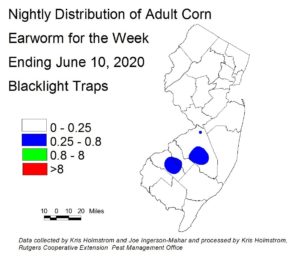 Widely scattered, but slightly increased catches of corn earworm (CEW) occurred this past week. As the earliest plantings (mainly in the south) proceed to full tassel and on to silk, even this low population can present a limited threat.
Widely scattered, but slightly increased catches of corn earworm (CEW) occurred this past week. As the earliest plantings (mainly in the south) proceed to full tassel and on to silk, even this low population can present a limited threat.
The highest nightly trap catches of CEW in black light traps for the week ending 6/10/20 are as follows:
| Califon 1 | Downer 1 | Green Creek 1 |
| Dayton 1 | Georgetown 1 | Tabernacle 1 |
Recorded Sessions Available: May 2020 “On-Farm Direct Marketing” Weekly Webinar Series
A weekly “On-Farm Direct Marketing” webinar series was hosted in May 2020, by Agricultural  Agents Michelle Infante-Casella, Meredith Melendez, William Bamka, Stephen Komar and Wesley Kline to educate famers selling directly to the public about changes occurring to the industry as a result of the COVID-19 pandemic. Four sessions in May were presented with the last session being a farmer panel discussion about changes on farms forced due to the pandemic. Farmers included Tracy Duffield – Duffield’s Farm Market, Dave Specca – Specca You-Pick Farm, and Jess Niederer – Chickadee Creek Organic Farm. In May, 145 participants attended this online series, offered on Tuesday Evenings from 7:00-8:00 PM. All sessions were recorded and are available to view online. The topics included the following:
Agents Michelle Infante-Casella, Meredith Melendez, William Bamka, Stephen Komar and Wesley Kline to educate famers selling directly to the public about changes occurring to the industry as a result of the COVID-19 pandemic. Four sessions in May were presented with the last session being a farmer panel discussion about changes on farms forced due to the pandemic. Farmers included Tracy Duffield – Duffield’s Farm Market, Dave Specca – Specca You-Pick Farm, and Jess Niederer – Chickadee Creek Organic Farm. In May, 145 participants attended this online series, offered on Tuesday Evenings from 7:00-8:00 PM. All sessions were recorded and are available to view online. The topics included the following:
Session 1: Maintaining Social Distancing and Food Safety Handling: Guidance for Farm Markets. Recording found at: https://go.rutgers.edu/pqalghh7 – Wesley Kline, Ag Agent, RCE of Cumberland Co. and Meredith Melendez, Ag Agent, RCE of Mercer Co.
Session 2: Meeting Customer Demands for New Jersey Agricultural Products in Response to the COVID-19 Pandemic. Recording found at: https://go.rutgers.edu/8u8r4qb8 – William Bamka, Ag Agent, RCE of Burlington Co. and Stephen Komar, RCE of Sussex County
Session 3: U-Pick Best Management Practices During COVID-10 and Executive Order Compliance. Recording found at: https://go.rutgers.edu/dy026twh – Meredith Melendez, Ag Agent, RCE of Mercer Co.
Session 4: Farmer Panel – Changes Made to On-Farm Direct Marketing Due to the COVID-19 Pandemic. Recording Found at: https://go.rutgers.edu/zm5msjt0 – Moderators & Co-Organizers: Meredith Melendez, RCE of Mercer Co. and Michelle Infante-Casella, RCE of Gloucester Co.
For more information on COVID-19 Farm Safety and other Food Safety resources see the Rutgers On-Farm Food Safety webpage.

